fuel pressure MITSUBISHI SHOGUN 2003 Owner's Manual (in English)
[x] Cancel search | Manufacturer: MITSUBISHI, Model Year: 2003, Model line: SHOGUN, Model: MITSUBISHI SHOGUN 2003Pages: 392, PDF Size: 14.34 MB
Page 9 of 392
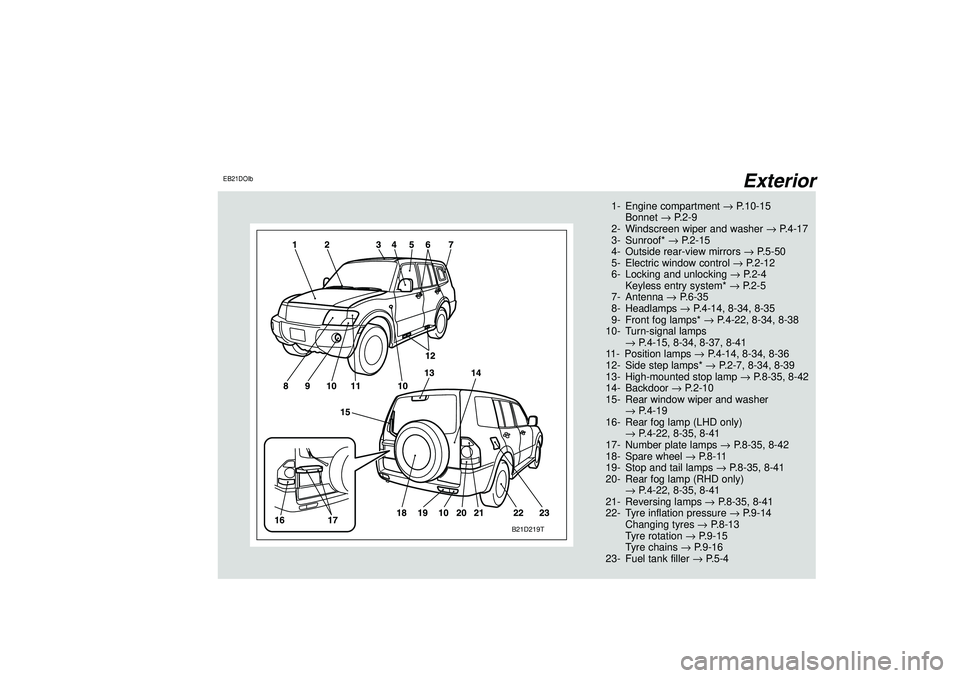
Exterior
EB21DOIb
B21D219T
1- Engine compartment→P.10-15
Bonnet→P.2-9
2- Windscreen wiper and washer→P.4-17
3- Sunroof*→P.2-15
4- Outside rear-view mirrors→P.5-50
5- Electric window control→P.2-12
6- Locking and unlocking→P.2-4
Keyless entry system*→P.2-5
7- Antenna→P.6-35
8- Headlamps→P.4-14, 8-34, 8-35
9- Front fog lamps*→P.4-22, 8-34, 8-38
10- Turn-signal lamps
→P.4-15, 8-34, 8-37, 8-41
11- Position lamps→P.4-14, 8-34, 8-36
12- Side step lamps*→P.2-7, 8-34, 8-39
13- High-mounted stop lamp→P.8-35, 8-42
14- Backdoor→P.2-10
15- Rear window wiper and washer
→P.4-19
16- Rear fog lamp (LHD only)
→P.4-22, 8-35, 8-41
17- Number plate lamps→P.8-35, 8-42
18- Spare wheel→P.8-11
19- Stop and tail lamps→P.8-35, 8-41
20- Rear fog lamp (RHD only)
→P.4-22, 8-35, 8-41
21- Reversing lamps→P.8-35, 8-41
22- Tyre inflation pressure→P.9-14
Changing tyres→P.8-13
Tyre rotation→P.9-15
Tyre chains→P.9-16
23- Fuel tank filler→P.5-4
Div:
Out put date:
Page 98 of 392
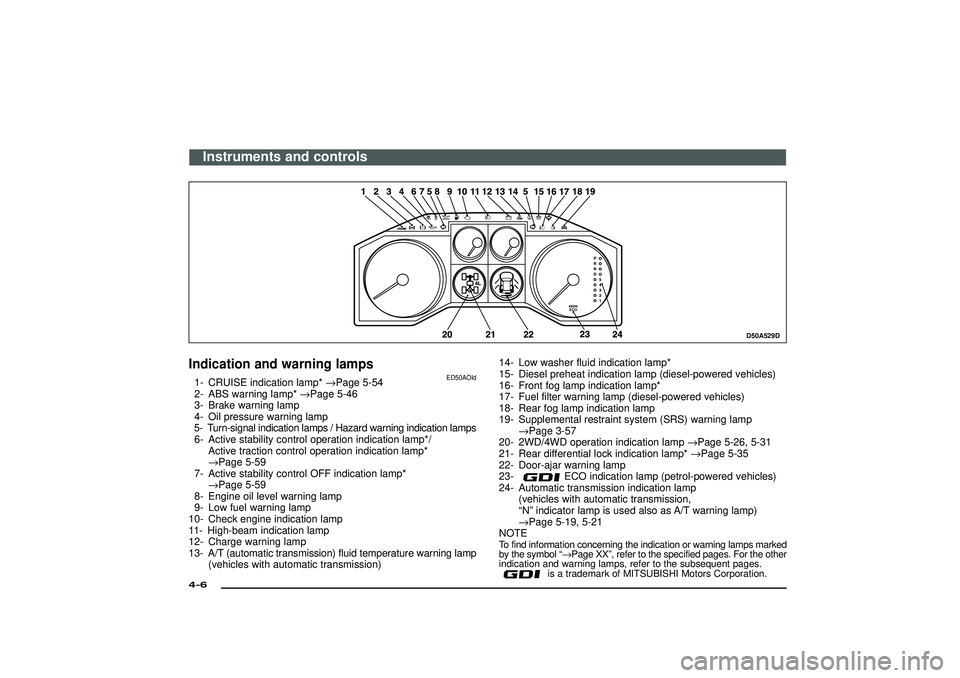
D50A529D
Indication and warning lamps
ED50AOId
1- CRUISE indication lamp*→Page 5-54
2- ABS warning lamp*→Page 5-46
3- Brake warning lamp
4- Oil pressure warning lamp
5- Turn-signal indication lamps / Hazard warning indication lamps
6- Active stability control operation indication lamp*/
Active traction control operation indication lamp*
→Page 5-59
7- Active stability control OFF indication lamp*
→Page 5-59
8- Engine oil level warning lamp
9- Low fuel warning lamp
10- Check engine indication lamp
11- High-beam indication lamp
12- Charge warning lamp
13- A/T (automatic transmission) fluid temperature warning lamp
(vehicles with automatic transmission)14- Low washer fluid indication lamp*
15- Diesel preheat indication lamp (diesel-powered vehicles)
16- Front fog lamp indication lamp*
17- Fuel filter warning lamp (diesel-powered vehicles)
18- Rear fog lamp indication lamp
19- Supplemental restraint system (SRS) warning lamp
→Page 3-57
20- 2WD/4WD operation indication lamp→Page 5-26, 5-31
21- Rear differential lock indication lamp*→Page 5-35
22- Door-ajar warning lamp
23-
ECO indication lamp (petrol-powered vehicles)
24- Automatic transmission indication lamp
(vehicles with automatic transmission,
“N”indicator lamp is used also as A/T warning lamp)
→Page 5-19, 5-21
NOTE
To find information concerning the indication or warning lamps marked
by the symbol“→Page XX”, refer to the specified pages. For the other
indication and warning lamps, refer to the subsequent pages.
is a trademark of MITSUBISHI Motors Corporation.
Instruments and controls
4-6Div:
Out put date:
Page 163 of 392
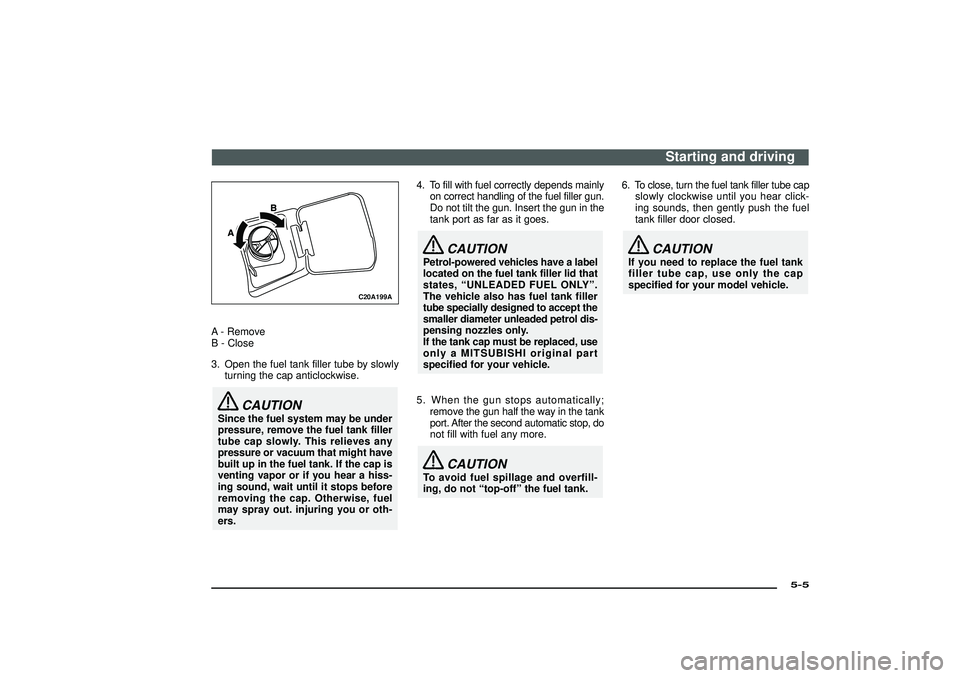
C20A199A
A - Remove
B - Close
3. Open the fuel tank filler tube by slowly
turning the cap anticlockwise.
CAUTION
Since the fuel system may be under
pressure, remove the fuel tank filler
tube cap slowly. This relieves any
pressure or vacuum that might have
built up in the fuel tank. If the cap is
venting vapor or if you hear a hiss-
ing sound, wait until it stops before
removing the cap. Otherwise, fuel
may spray out. injuring you or oth-
ers.4. To fill with fuel correctly depends mainly
on correct handling of the fuel filler gun.
Do not tilt the gun. Insert the gun in the
tank port as far as it goes.
CAUTION
Petrol-powered vehicles have a label
located on the fuel tank filler lid that
states,“UNLEADED FUEL ONLY”.
The vehicle also has fuel tank filler
tube specially designed to accept the
smaller diameter unleaded petrol dis-
pensing nozzles only.
If the tank cap must be replaced, use
only a MITSUBISHI original part
specified for your vehicle.
5. When the gun stops automatically;
remove the gun half the way in the tank
port. After the second automatic stop, do
not fill with fuel any more.
CAUTION
To avoid fuel spillage and overfill-
ing, do not“top-off”the fuel tank.6. To close, turn the fuel tank filler tube cap
slowly clockwise until you hear click-
ing sounds, then gently push the fuel
tank filler door closed.
CAUTION
If you need to replace the fuel tank
filler tube cap, use only the cap
specified for your model vehicle.
Starting and driving
5-5
Div:
Out put date:
Page 165 of 392
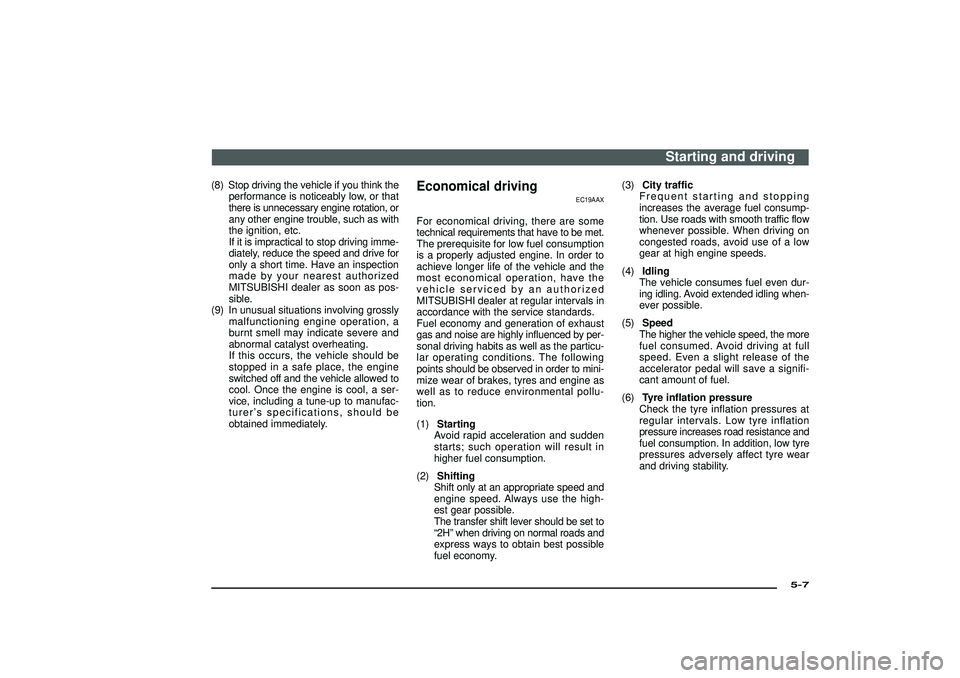
(8) Stop driving the vehicle if you think the
performance is noticeably low, or that
there is unnecessary engine rotation, or
any other engine trouble, such as with
the ignition, etc.
If it is impractical to stop driving imme-
diately, reduce the speed and drive for
only a short time. Have an inspection
made by your nearest authorized
MITSUBISHI dealer as soon as pos-
sible.
(9) In unusual situations involving grossly
malfunctioning engine operation, a
burnt smell may indicate severe and
abnormal catalyst overheating.
If this occurs, the vehicle should be
stopped in a safe place, the engine
switched off and the vehicle allowed to
cool. Once the engine is cool, a ser-
vice, including a tune-up to manufac-
turer’s specifications, should be
obtained immediately.
Economical driving
EC19AAX
For economical driving, there are some
technical requirements that have to be met.
The prerequisite for low fuel consumption
is a properly adjusted engine. In order to
achieve longer life of the vehicle and the
most economical operation, have the
vehicle serviced by an authorized
MITSUBISHI dealer at regular intervals in
accordance with the service standards.
Fuel economy and generation of exhaust
gas and noise are highly influenced by per-
sonal driving habits as well as the particu-
lar operating conditions. The following
points should be observed in order to mini-
mize wear of brakes, tyres and engine as
well as to reduce environmental pollu-
tion.
(1)Starting
Avoid rapid acceleration and sudden
starts; such operation will result in
higher fuel consumption.
(2)Shifting
Shift only at an appropriate speed and
engine speed. Always use the high-
est gear possible.
The transfer shift lever should be set to
“2H”when driving on normal roads and
express ways to obtain best possible
fuel economy.(3)City traffic
Frequent starting and stopping
increases the average fuel consump-
tion. Use roads with smooth traffic flow
whenever possible. When driving on
congested roads, avoid use of a low
gear at high engine speeds.
(4)Idling
The vehicle consumes fuel even dur-
ing idling. Avoid extended idling when-
ever possible.
(5)Speed
The higher the vehicle speed, the more
fuel consumed. Avoid driving at full
speed. Even a slight release of the
accelerator pedal will save a signifi-
cant amount of fuel.
(6)Tyre inflation pressure
Check the tyre inflation pressures at
regular intervals. Low tyre inflation
pressure increases road resistance and
fuel consumption. In addition, low tyre
pressures adversely affect tyre wear
and driving stability.
Starting and driving
5-7
Div:
Out put date:
Page 196 of 392
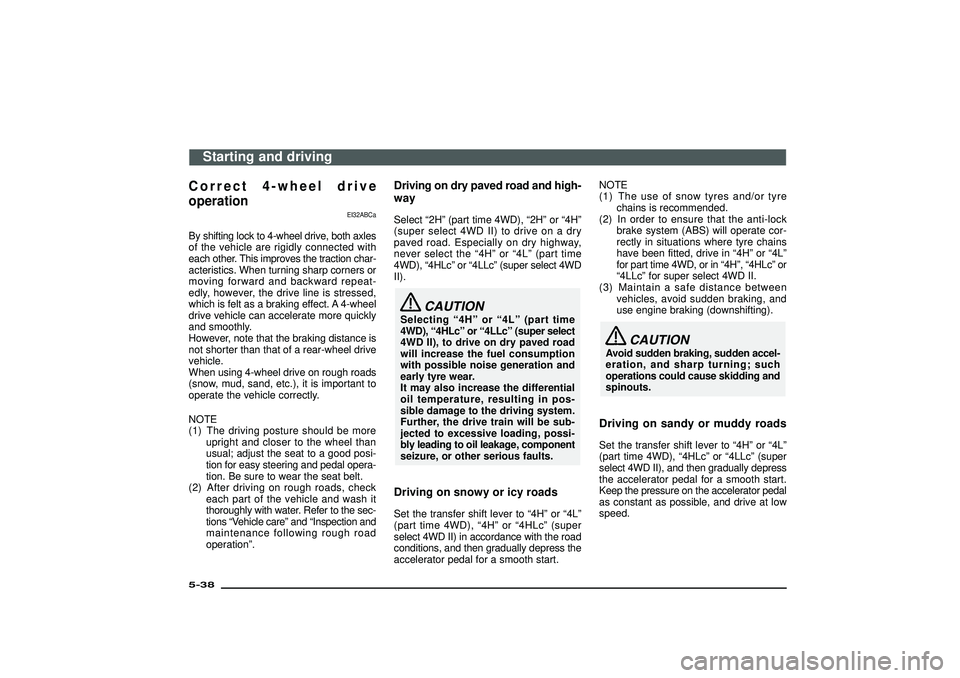
Correct 4-wheel drive
operation
EI32ABCa
By shifting lock to 4-wheel drive, both axles
of the vehicle are rigidly connected with
each other. This improves the traction char-
acteristics. When turning sharp corners or
moving forward and backward repeat-
edly, however, the drive line is stressed,
which is felt as a braking effect. A 4-wheel
drive vehicle can accelerate more quickly
and smoothly.
However, note that the braking distance is
not shorter than that of a rear-wheel drive
vehicle.
When using 4-wheel drive on rough roads
(snow, mud, sand, etc.), it is important to
operate the vehicle correctly.
NOTE
(1) The driving posture should be more
upright and closer to the wheel than
usual; adjust the seat to a good posi-
tion for easy steering and pedal opera-
tion. Be sure to wear the seat belt.
(2) After driving on rough roads, check
each part of the vehicle and wash it
thoroughly with water. Refer to the sec-
tions“Vehicle care”and“Inspection and
maintenance following rough road
operation”.
Driving on dry paved road and high-
waySelect“2H”(part time 4WD),“2H”or“4H”
(super select 4WD II) to drive on a dry
paved road. Especially on dry highway,
never select the“4H”or“4L”(part time
4WD),“4HLc”or“4LLc”(super select 4WD
II).
CAUTION
Selecting“4H”or“4L”(part time
4WD),“4HLc”or“4LLc”(super select
4WD II), to drive on dry paved road
will increase the fuel consumption
with possible noise generation and
early tyre wear.
It may also increase the differential
oil temperature, resulting in pos-
sible damage to the driving system.
Further, the drive train will be sub-
jected to excessive loading, possi-
bly leading to oil leakage, component
seizure, or other serious faults.Driving on snowy or icy roadsSet the transfer shift lever to“4H”or“4L”
(part time 4WD),“4H”or“4HLc”(super
select 4WD II) in accordance with the road
conditions, and then gradually depress the
accelerator pedal for a smooth start.NOTE
(1) The use of snow tyres and/or tyre
chains is recommended.
(2) In order to ensure that the anti-lock
brake system (ABS) will operate cor-
rectly in situations where tyre chains
have been fitted, drive in“4H”or“4L”
for part time 4WD, or in“4H”,“4HLc”or
“4LLc”for super select 4WD II.
(3) Maintain a safe distance between
vehicles, avoid sudden braking, and
use engine braking (downshifting).
CAUTION
Avoid sudden braking, sudden accel-
eration, and sharp turning; such
operations could cause skidding and
spinouts.Driving on sandy or muddy roadsSet the transfer shift lever to“4H”or“4L”
(part time 4WD),“4HLc”or“4LLc”(super
select 4WD II), and then gradually depress
the accelerator pedal for a smooth start.
Keep the pressure on the accelerator pedal
as constant as possible, and drive at low
speed.
Starting and driving
5-38Div:
Out put date:
Page 343 of 392
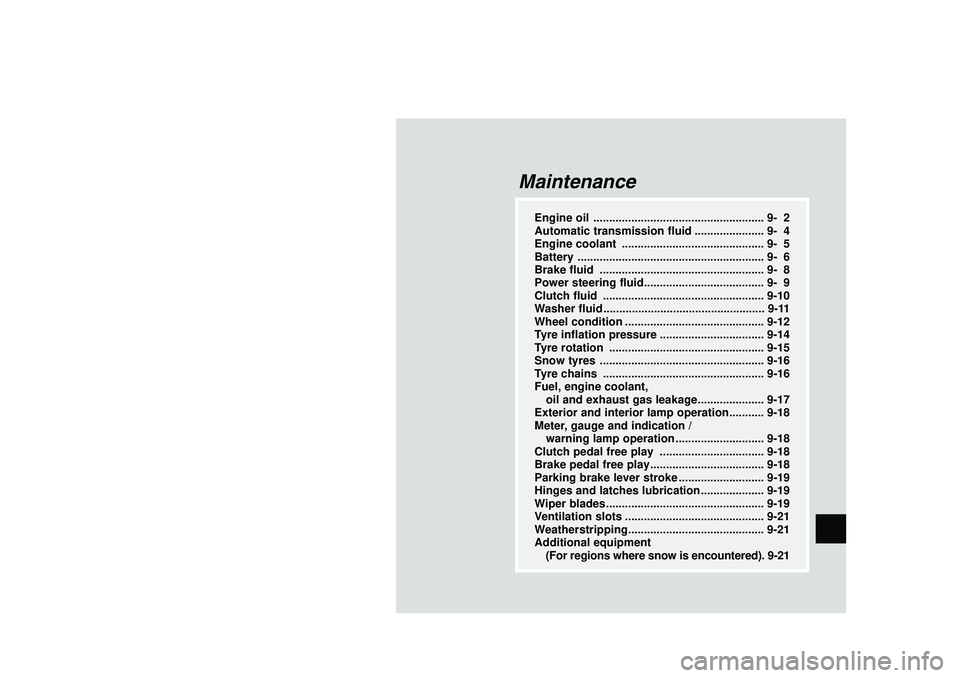
Maintenance
Engine oil ...................................................... 9- 2
Automatic transmission fluid ...................... 9- 4
Engine coolant ............................................. 9- 5
Battery ........................................................... 9- 6
Brake fluid .................................................... 9- 8
Power steering fluid...................................... 9- 9
Clutch fluid ................................................... 9-10
Washer fluid ................................................... 9-11
Wheel condition ............................................ 9-12
Tyre inflation pressure ................................. 9-14
Tyre rotation ................................................. 9-15
Snow tyres .................................................... 9-16
Tyre chains ................................................... 9-16
Fuel, engine coolant,
oil and exhaust gas leakage..................... 9-17
Exterior and interior lamp operation........... 9-18
Meter, gauge and indication /
warning lamp operation ............................ 9-18
Clutch pedal free play ................................. 9-18
Brake pedal free play.................................... 9-18
Parking brake lever stroke ........................... 9-19
Hinges and latches lubrication.................... 9-19
Wiper blades.................................................. 9-19
Ventilation slots ............................................ 9-21
Weatherstripping........................................... 9-21
Additional equipment
(For regions where snow is encountered). 9-21
Div:
Out put date:
Page 383 of 392

Parking ............................................................... 5-43
Parking brake ..................................................... 5-42
Parking brake lever stroke ................................. 9-19
Part time 4WD ................................................... 5-24
Performance ...................................................... 10-7
Power steering fluid ............................................. 9-9
Power steering system ...................................... 5-49
Pregnant women restraint .................................. 3-41
Rear differential lock .......................................... 5-34
Rear fog lamp switch ......................................... 4-22
Rear heater/Rear air conditioning ...................... 6-52
Rear seat (3-door models)/Second seat (5-door models) ......................... 3-12
Rear shelf (3-door models) ................................ 6-69
Rear side/quarter window .................................. 2-15
Rear window demister switch ............................ 4-21
Rear window wiper and washer switch .............. 4-19
Removal of water from the fuel filter (diesel- powered vehicles only) ...................... 8-24
Replacement of lamp bulbs ............................... 8-34
Rheostat (meter illumination control) ................. 4-23
Roof carrier precaution ....................................... 1-11
Room lamps ....................................................... 4-24
Running-in recommendations .............................. 5-2
RV meter ............................................................ 4-40
Safe driving techniques ..................................... 1-13
Seat adjustment ................................................... 3-3
Seat arrangement ................................................ 3-3
Seat belt inspection ........................................... 3-41
Seat belts ........................................................... 3-30
Side box ............................................................. 6-67
Snow tyres ......................................................... 9-16
Spare wheel ....................................................... 8-11
Speedometer ....................................................... 4-2
Starting ............................................................... 5-12
Steering wheel height adjustment ...................... 5-49
Sun visors .......................................................... 6-56
Sunroof .............................................................. 2-15
Super select 4WD II (SS4 II) ............................. 5-28
Supplemental restraint system (SRS)-air bag ... 3-42 Tachometer .......................................................... 4-3
Third seat (5-door models) ................................ 3-14
Tools and jack ...................................................... 8-3
Towing ................................................................ 8-17
Trailer towing ....................................................... 5-8
Transmission ...................................................... 10-9
Tyre chains ......................................................... 9-16
Tyre inflation pressure ....................................... 9-14
Tyre rotation ....................................................... 9-15
Tyres and wheels ............................................. 10-10
UKW/MW/LW electronic tuning radio
with CD player ................................................ 6-17
UKW/MW/LW electronic tuning radio with tape player ................................................ 6-2
Used engine oils safety instructions .................. 1-13
Vanity mirror ....................................................... 6-58
Vehicle identification number plate (RHD vehicles only) ....................................... 10-3
Vehicle information code plate ........................... 10-3
Ventilation slots .................................................. 9-21
Ventilators .......................................................... 6-35
Washer fluid ....................................................... 9-11
Water temperature gauge .................................... 4-5
Weatherstripping ................................................ 9-21
Weight ................................................................ 10-7
Wheel condition ................................................. 9-12
Windscreen wiper and washer switch ................ 4-17
Wiper blades ............................................... 7-7, 9-19
Wiper deicer switch ........................................... 4-24
Alphabetical index
10 -19
Div:
Out put date: